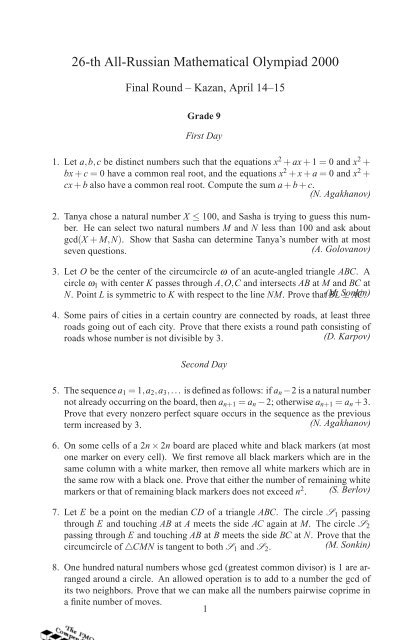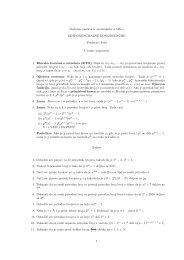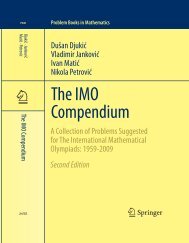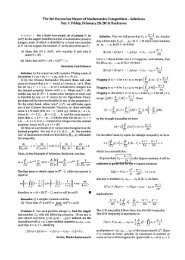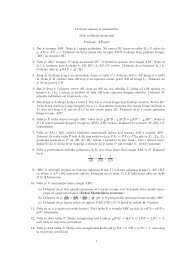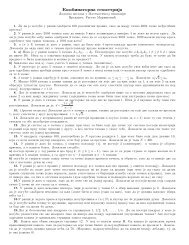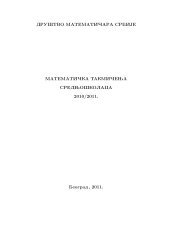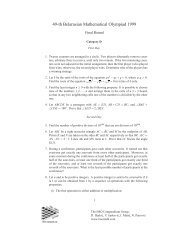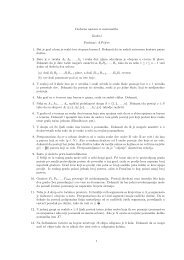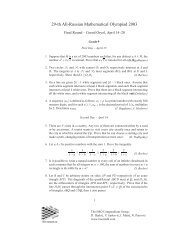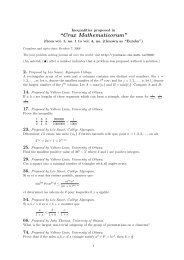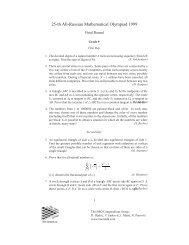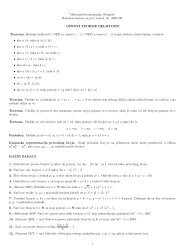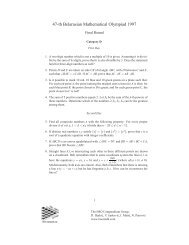26-th All-Russian Mathematical Olympiad 2000 - IMOmath
26-th All-Russian Mathematical Olympiad 2000 - IMOmath
26-th All-Russian Mathematical Olympiad 2000 - IMOmath
Create successful ePaper yourself
Turn your PDF publications into a flip-book with our unique Google optimized e-Paper software.
<strong>26</strong>-<strong>th</strong> <strong>All</strong>-<strong>Russian</strong> Ma<strong>th</strong>ematical <strong>Olympiad</strong> <strong>2000</strong><br />
Final Round – Kazan, April 14–15<br />
Grade 9<br />
First Day<br />
1. Let a,b,c be distinct numbers such <strong>th</strong>at <strong>th</strong>e equations x 2 + ax+1 = 0 and x 2 +<br />
bx+c = 0 have a common real root, and <strong>th</strong>e equations x 2 + x+a = 0 and x 2 +<br />
cx+b also have a common real root. Compute <strong>th</strong>e sum a+b+c.<br />
(N. Agakhanov)<br />
2. Tanya chose a natural number X ≤ 100, and Sasha is trying to guess <strong>th</strong>is number.<br />
He can select two natural numbers M and N less <strong>th</strong>an 100 and ask about<br />
gcd(X + M,N). Show <strong>th</strong>at Sasha can determine Tanya’s number wi<strong>th</strong> at most<br />
seven questions.<br />
(A. Golovanov)<br />
3. Let O be <strong>th</strong>e center of <strong>th</strong>e circumcircle ω of an acute-angled triangle ABC. A<br />
circle ω 1 wi<strong>th</strong> center K passes <strong>th</strong>rough A,O,C and intersects AB at M and BC at<br />
N. Point L is symmetric to K wi<strong>th</strong> respect to <strong>th</strong>e line NM. Prove <strong>th</strong>at(M. BLSonkin)<br />
⊥ AC.<br />
4. Some pairs of cities in a certain country are connected by roads, at least <strong>th</strong>ree<br />
roads going out of each city. Prove <strong>th</strong>at <strong>th</strong>ere exists a round pa<strong>th</strong> consisting of<br />
roads whose number is not divisible by 3.<br />
(D. Karpov)<br />
Second Day<br />
5. The sequence a 1 = 1,a 2 ,a 3 ,... is defined as follows: if a n −2 is a natural number<br />
not already occurring on <strong>th</strong>e board, <strong>th</strong>en a n+1 = a n − 2; o<strong>th</strong>erwise a n+1 = a n + 3.<br />
Prove <strong>th</strong>at every nonzero perfect square occurs in <strong>th</strong>e sequence as <strong>th</strong>e previous<br />
term increased by 3.<br />
(N. Agakhanov)<br />
6. On some cells of a 2n × 2n board are placed white and black markers (at most<br />
one marker on every cell). We first remove all black markers which are in <strong>th</strong>e<br />
same column wi<strong>th</strong> a white marker, <strong>th</strong>en remove all white markers which are in<br />
<strong>th</strong>e same row wi<strong>th</strong> a black one. Prove <strong>th</strong>at ei<strong>th</strong>er <strong>th</strong>e number of remaining white<br />
markers or <strong>th</strong>at of remaining black markers does not exceed n 2 . (S. Berlov)<br />
7. Let E be a point on <strong>th</strong>e median CD of a triangle ABC. The circle S 1 passing<br />
<strong>th</strong>rough E and touching AB at A meets <strong>th</strong>e side AC again at M. The circle S 2<br />
passing <strong>th</strong>rough E and touching AB at B meets <strong>th</strong>e side BC at N. Prove <strong>th</strong>at <strong>th</strong>e<br />
circumcircle of △CMN is tangent to bo<strong>th</strong> S 1 and S 2 .<br />
(M. Sonkin)<br />
8. One hundred natural numbers whose gcd (greatest common divisor) is 1 are arranged<br />
around a circle. An allowed operation is to add to a number <strong>th</strong>e gcd of<br />
its two neighbors. Prove <strong>th</strong>at we can make all <strong>th</strong>e numbers pairwise coprime in<br />
a finite number of moves.<br />
1
(S. Berlov)<br />
Grade 10<br />
First Day<br />
[ 2<br />
0]<br />
1. Evaluate <strong>th</strong>e sum +<br />
3<br />
[ 2<br />
1<br />
3<br />
]<br />
+<br />
[ 2<br />
2<br />
3<br />
]<br />
+ ···+<br />
[ 2<br />
1000<br />
3<br />
]<br />
.<br />
(A. Golovanov)<br />
2. Let −1 < x 1 < x 2 < ··· < x n < 1 and x 13<br />
Prove <strong>th</strong>at if y 1 < y 2 < ··· < y n , <strong>th</strong>en<br />
1 + x13<br />
2 + ···+x13 n = x 1 + x 2 + ···+x n .<br />
x 13<br />
1 y 1 + ···+ x 13<br />
n y n < x 1 y 1 + x 2 y 2 + ···+ x n y n .<br />
(O. Musin)<br />
3. In an acute scalene triangle ABC <strong>th</strong>e bisector of <strong>th</strong>e acute angle betweeen <strong>th</strong>e<br />
altitudes AA 1 and CC 1 meets <strong>th</strong>e sides AB and BC at P and Q respectively. The<br />
bisector of <strong>th</strong>e angle B intersects <strong>th</strong>e segment joining <strong>th</strong>e or<strong>th</strong>ocenter of ABC and<br />
<strong>th</strong>e midpoint of AC at point R. Prove <strong>th</strong>at P,B,Q,R lie on a circle. (S. Berlov)<br />
4. We are given five equal-looking weights of pairwise distinct masses. For any<br />
<strong>th</strong>ree weights A,B,C, we can check by a measuring if m(A) < m(B) < m(C),<br />
where m(X) denotes <strong>th</strong>e mass of a weight X (<strong>th</strong>e answer is yes or no). Can we<br />
always arrange <strong>th</strong>e masses of <strong>th</strong>e weights in <strong>th</strong>e increasing order wi<strong>th</strong> at most<br />
nine measurings<br />
(O. Podlipskiy)<br />
Second Day<br />
5. Let M be a finite set of numbers, such <strong>th</strong>at among any <strong>th</strong>ree of its elements <strong>th</strong>ere<br />
are two whose sum belongs to M. Find <strong>th</strong>e greatest possible number of elements<br />
of M.<br />
(E. Cherepanov)<br />
6. A perfect number, greater <strong>th</strong>an 6, is divisible by 3. Prove <strong>th</strong>at it is also divisible<br />
by 9. (A natural number is perfect if <strong>th</strong>e sum of its proper divisors is equal to <strong>th</strong>e<br />
number itself: e.g. 6 = 1+2+3.)<br />
(A. Hrabrov)<br />
7. Two circles are internally tangent at point N. Chords BA and BC of <strong>th</strong>e larger<br />
circle touch <strong>th</strong>e smaller circle at K and M respectively. Let Q and P be <strong>th</strong>e<br />
midpoints of <strong>th</strong>e arcs AB and BC respectively. The circumcircles of <strong>th</strong>e triangles<br />
BQK and BPM meet again at B 1 . Prove <strong>th</strong>at BPB 1 Q is a parallelogram. (T. Emelyanov)<br />
8. Some paper squares of k distinct colors are placed on a rectangular table, wi<strong>th</strong><br />
sides parallel to <strong>th</strong>e sides of <strong>th</strong>e table. Suppose <strong>th</strong>at for any k squares of distinct<br />
colors, some two of <strong>th</strong>em can be nailed on <strong>th</strong>e table wi<strong>th</strong> only one nail. Prove<br />
<strong>th</strong>at <strong>th</strong>ere is a color such <strong>th</strong>at all squares of <strong>th</strong>at color can<br />
2
e nailed wi<strong>th</strong> 2k − 2 nails.<br />
(V. Dolnikov)<br />
Grade 11<br />
First Day<br />
1. Determine all functions f : R → R such <strong>th</strong>at for all real x,y,z,<br />
f(x+y)+ f(y+z)+ f(z+x) ≥ 3 f(x+2y+3z).<br />
(N. Agakhanov, O. Podlipskiy)<br />
2. Prove <strong>th</strong>at one can partition <strong>th</strong>e set of natural numbers into 100 nonempty subsets<br />
such <strong>th</strong>at among any <strong>th</strong>ree natural numbers a,b,c satisfying a+99b = c, <strong>th</strong>ere<br />
are two <strong>th</strong>at belong to <strong>th</strong>e same subset.<br />
(F. Petrov, I. Bogdanov, S. Berlov, D. Djukić)<br />
3. A convex pentagon ABCDE is given in <strong>th</strong>e coordinate plane wi<strong>th</strong> all vertices in<br />
lattice points. Prove <strong>th</strong>at <strong>th</strong>ere must be at least one lattice point in <strong>th</strong>e pentagon<br />
determined by <strong>th</strong>e diagonals AC,BD,CE,DA,EB or on(V. itsDolnikov, boundary. I. Bogdanov)<br />
4. Let be given a sequence of nonnegative integers a 1 ,a 2 ,...,a n . For k = 1,2,...,n,<br />
denote<br />
a k−l+1 + a k−l+2 + ···+ a k<br />
m k = max<br />
.<br />
1≤l≤k<br />
l<br />
Prove <strong>th</strong>at for every α > 0 <strong>th</strong>e number of values of k for which m k > α is less<br />
<strong>th</strong>an a 1 + a 2 + ···+ a n<br />
. (V. Dolnikov)<br />
α<br />
Second Day<br />
5. Prove <strong>th</strong>e inequality sin n (2x)+(sin n x − cos n x) 2 ≤ 1. (A. Hrabrov)<br />
6. A perfect number, greater <strong>th</strong>an 28, is divisible by 7. Prove <strong>th</strong>at it is also divisible<br />
by 49.<br />
(A. Hrabrov)<br />
7. A quadrilateral ABCD is circumscribed about a circle ω. The lines AB and CD<br />
meet at O. A circle ω 1 is tangent to side BC at K and to <strong>th</strong>e extensions of sides<br />
AB and CD, and a circle ω 2 is tangent to side AD at L and to <strong>th</strong>e extensions<br />
of sides AB and CD. Suppose <strong>th</strong>at points O,K,L lie on a line. Prove <strong>th</strong>at <strong>th</strong>e<br />
midpoints of BC and AD and <strong>th</strong>e center of ω also lie on a line. (P. Kozhevnikov)<br />
8. The cells of a 100 × 100 board are painted in four colors in such a way <strong>th</strong>at every<br />
row and every column contains exactly 25 cells of each color. Prove <strong>th</strong>at <strong>th</strong>ere<br />
exist two rows and two columns, whose four intersection cells are all of distinct<br />
colors.<br />
(S. Berlov)<br />
3


